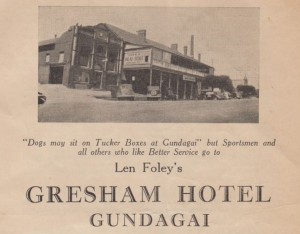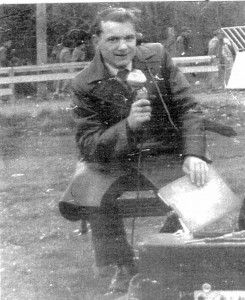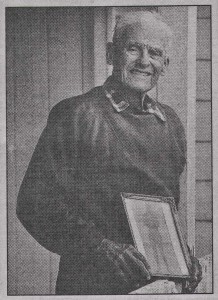This great video from about 1960 is courtesy of Matt from the Twin Town Times. It includes Harden v Temora and Harden v Young. How many players can you identify?
Tag Archives: Young
The Hall Brothers
The danger in writing of the Hall brothers is that most of the population of Young and places thereabouts seem to be related to them, and thus will find errors and omissions. The advantage is that you will be gracious and contribute stories, corrections and improvements.
There were other prolific sporting families about, such as the Weissels of Cootamundra, footballing families like the Broads of West Wyalong, the Lawrences of Barmedman, and the Templeman brothers of Bellarwi, but nothing quite like the Hall brothers of Belowra, Wambanumba, Murringo, Bendick Murrell and Young. It’s not that the family lived in all these places, but being in the vicinity they represented them all in some way. Continue reading
Old Films of the Maher Cup, People & Life in & around Harden-Murrumburrah
 These two 20 minute (approx) videos, linked below and now placed on You Tube, are from a found film reel that was given to Wal Galvin of Cootamundra on DVD. The creator is unknown. It is uncaptioned and silent. Two things are clear from watching. They were amateur films shot in the early 1950s. The main town featured is Harden-Murrumburrah, with some film also from Young and Goulburn as well as from a farm.
These two 20 minute (approx) videos, linked below and now placed on You Tube, are from a found film reel that was given to Wal Galvin of Cootamundra on DVD. The creator is unknown. It is uncaptioned and silent. Two things are clear from watching. They were amateur films shot in the early 1950s. The main town featured is Harden-Murrumburrah, with some film also from Young and Goulburn as well as from a farm.
It would be wonderful to fill in the gaps. Who are the people? What Rugby League matches are being played and where? (Roberts Park, Murrumburrah?) What about the other sports the buildings and towns? So much to discover. Please leave some comments if you know. Continue reading
A Brief History of the Maher Cup Clubs in Graphs
Graphically representing the number of matches played by each club helps illustrate the highs and lows of their footballing journeys over the 52 years of the Maher Cup history, and provides the basis of a brief club history. Failure to capture the Cup meant twiddling thumbs and fretting on the outcome of the next draw.
Cootamundra (224 matches). Playing 62 games more than any other team, Coota started with a bang in 1922 winning in its first game under Phil Regan – the first paid-player coach in the bush. They didn’t let up. Regan’s 1920s blue and whites, featuring players such as Eric Weissel, Jack Kingston, Bill Lesberg and Gordon Hinton utterly dominated their opponents. With a little help they even took on England. During the Depression years, after Regan departed, it all fell apart for a while. 1935 saw the purchase of five paid players, an embarrassing loss to Tumut, and the imports instantly sacked. Coota rose to the top again in 1939 with a team composed mainly of local ex-De La Salle boys. After the war Herb Narvo (1947) and Johnny Graves (1954) led teams of extraordinary quality. Reverting to mainly local players the town continued to be consistently competitive into the 1960s. Continue reading
2LF’s History of the Maher Cup
 This old book from 1940, probably the first attempt to record in any detail the history of the Maher Cup, has been kindly shared with this site by a player of the time. The book promoted 2LF’s live broadcasts which had commenced in 1938. Initially there were complaints from clubs that these broadcasts ‘hurt the gate’. However they did much to develop a deep interest in the game throughout the region at a time when people huddled around their radios for entertainment. Continue reading
This old book from 1940, probably the first attempt to record in any detail the history of the Maher Cup, has been kindly shared with this site by a player of the time. The book promoted 2LF’s live broadcasts which had commenced in 1938. Initially there were complaints from clubs that these broadcasts ‘hurt the gate’. However they did much to develop a deep interest in the game throughout the region at a time when people huddled around their radios for entertainment. Continue reading
John O’Reilly
 This website/blog owes its existence to John O’Reilly. In the 1950s he made our small town football the dramatic heart of our lives. Women were seduced by his mellifluous tones, children were drawn in by his rich word pictures. No one has done it better.
This website/blog owes its existence to John O’Reilly. In the 1950s he made our small town football the dramatic heart of our lives. Women were seduced by his mellifluous tones, children were drawn in by his rich word pictures. No one has done it better.
My mother hated the drinking and gambling that she associated with many of the men of rugby league – but she loved listening to the calls of John O’Reilly on 2LF. On Saturday afternoons we would gather around the radio.
I’d grown up listening to John O’Reilly calling the Maher Cup. I still think he was the best footy caller I’ve ever heard on radio. He had a silky-smooth voice, and he was incredibly accurate. …… I wanted to follow John to the big smoke. I just hoped I’d one day be as good as he was.
Stan Gibbs’ Memories of the Maher Cup Cootamundra 1938-1946
My memories of the Maher Cup are through the eyes of a young boy and teenager.
Before the War, my father took me on a pushbike to Fisher Oval where I saw my first match. When I was older, Dad and I spent the day in Young having travelled there by a special train. Young must have won that day, as I can vaguely remember the elation of Bill Kearney, the coach of the Young team. Continue reading
Graham English Remembers Young & the Maher Cup in the 1950s.
I was born at Young in 1944 and lived there until 1960. In those days we knew little of Sydney football. Everything was Group 9 or Maher Cup. Radio 2LF at Young had John O’Reilly broadcasting the Maher Cup games. O’Reilly was a great football broadcaster. He could make the dullest game sound exciting. I’ve heard they are going to put Ray Warren and Frank Hyde into some hall of fame of rugby league commentators but O’Reilly should be there too. He later came to Sydney and described the league on the ABC.
Young v Grenfell 9 August 1939
Games That Changed the Game No.3
The Grenfell Greens had not achieved much in Maher Cup football. Until 1938 their challenges had been limited to just four – all lost, with just 13 points earned and 80 conceded.
However by the late thirties the best teams – Young, West Wyalong, Temora and Cowra. were from the northern part of Maher Cup country. Grenfell was keen to get into action against its traditional rivals. Not having enough local talent they decided to go and buy a team. Continue reading
Population Change in Maher Cup Country
In 1954 the Boorowa News provided the following estimates of town and district populations of the twelve “Group Nine towns”.
Cowra: town 7,000; district 15,000
Tumut: 3,500 and 13,000 (including Adelong and Batlow)
Young: 4,500 and 12,000
Cootamundra: 6,000 and 10,000 Continue reading
